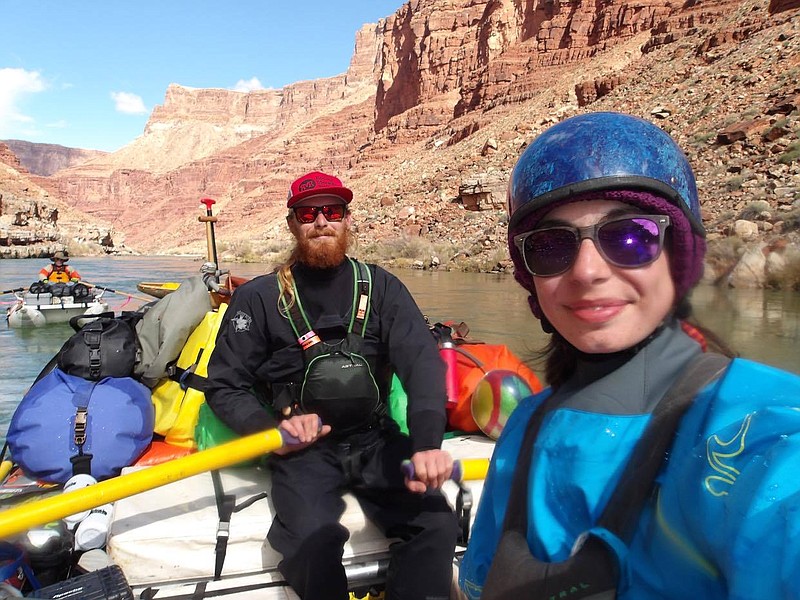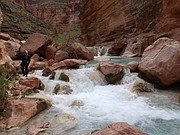A week into their rafting trip, news of the escalating coronavirus crisis reached the bottom of the Grand Canyon - where 16 paddlers were weathering a different storm: freak headwinds so strong they blew the one-ton rafts backwards and blasted the paddlers with sand.
"Face masks and gloves were our best friends," said Becky Piña, a Fort Payne, Alabama, native who joined the trip with her boyfriend, Jerrod Jones.
It was Piña's first time down the canyon and Jones' fifth. "My hands were all beat up," she said. "But I was excited about it. I was working. I was doing something."
For many, a raft trip through the Grand Canyon is a once-in-a-lifetime experience. Each year, the National Park Service holds a lottery, awarding just a few hundred permits to the thousands that apply. The trips may last anywhere between 12 and 25 days. During that time, river-trippers navigate 279 miles - which includes some of the biggest whitewater in the U.S. - while carrying everything they'll need to survive: food; tents; first-aid kits.
Paddlers are separated from society by mile-high canyon walls, and the isolation can be as challenging as it is liberating.
But between the elements and the news they had begun to receive via satellite phone, the mood of that March trip was tense.
One night, as they sat glumly around camp, Jones told his friends, "Look, before we can do anything about the [virus], we have to get out of here. So let's worry about Lava [rapid] coming up. Because you have to get through that before you can get through your flight home."
***
On March 10, Piña and Jones, along with 14 friends, launched from Lees Ferry on the Colorado River.
At the time, the coronavirus still felt far away. The U.S. had just over 1,000 confirmed cases, and Alabama had none. (Before their 18-day trip was over, however, the U.S. would break 100,000 confirmed cases.)
"I just thought that by the time we got out, medicine and technology would get a handle on things," Jones said.
For the first week of the trip, talk of the coronavirus was minimal. The worst headwinds would not pick up until further downstream, so the paddlers focused on more immediate problems, like navigating the rapids.
Grand Canyon whitewater is famous for its big features: waves the size of a double-decker bus and hydraulics large enough to swallow one.
"I had never been in water that big before," said Piña.
On day seven, as the rafts approached the thunderous roar of Hance, their largest rapid so far, Piña asked herself, "'Can I do this? Am I going to be OK?'"
At the oars, Jones planned to follow a right-to-left line to avoid the raft-flipping holes at the top and the bottom. Piña's heart pounded as they crested the first wave. Then, Jones lost momentum. He furiously began to back-paddle. As he pulled right, the raft dropped over a large rock and stalled in the hole behind it.
Water pounded them in place and the raft began to buckle, its metal frame creaking. Jones yanked on his oars. Seconds later, they were skirting past the bottom hole and into the calm water below.
"Hance was my favorite," Piña said afterward, giddy from having survived her first big-water rapid.
Later that day, the paddlers landed at Phantom Ranch, a hikers lodge accessible only by foot, donkey or boat, and a popular pit-stop for sending postcards. At the trailhead, was a message board and, on it, a note to one of the men on their trip, asking him to visit the ranger station.
His wife, it turned out, frantically wanted to reach him. By then, the coronavirus had been declared a national emergency. Airlines were beginning to suspend flights, and cities were enacting shelter-in-place orders. She worried he wouldn't be able to get home. And now her worry spread through the group.
Over the following days, their satellite phone became flooded with news from friends and family - though the news was not always accurate. Stores were out of everything; states were shut down; the interstate system could be next, they were told.
On day 11, they learned the park was closing and future river trips had been suspended.
"That's when we knew it was getting real," Piña said.
But they pushed on. By day, they paddled. Past desert scrub and bighorn sheep. Past ancient strata streaked red, yellow and white. Then, on day 14, they came to Lava Falls, the highest-rated rapid in the canyon.
Despite their preoccupations, their runs all went smoothly - as smoothly as possible when riding a maelstrom of breaking waves and dangerous holes. Just downstream, the paddlers landed at Tequila Beach, where it is tradition to stop and celebrate making it through the canyon's most notorious rapid.
As the paddlers climbed from their rafts, the skies opened up, and momentarily all their worries washed away. For an hour, they celebrated in the rain.
But in the evenings, at camp, the talk inevitably turned back to the coronavirus. Some wanted to abandon the trip and hike out, though options are limited in regards to finding a trail to the rim and coordinating a shuttle once there. Jones and Piña were among those who wanted to stay. A group meeting was called, and collectively they decided the best thing to do was to limit texting and try to enjoy the trip.
What was to gain by leaving early, Piña had asked.
"In here, at least you have somewhat of a plan," Jones said. "You know you're going downriver."
Except, of course, when powerful headwinds forced them upstream. The closer they got to the takeout, the harder the winds seemed to push. On the worst day, they fought their way past the same landmark three times.
When they reached the takeout at Pearce Ferry, the wind finally dissipated, but the tension, Piña remembered, seemed to swell like a rogue canyon wave. The next day, the 16 paddlers would begin their journeys home - to Alabama, to Georgia, to Colorado, to whatever lay ahead.
"Life in the canyon is simple," said Jones. "You've got your food, your equipment and the people you're with. I think what's happening in the world right now, people are realizing the difference between what they thought they needed versus what's really important."
Contact Sunny Montgomery at smontgomery@timesfreepress.com.

